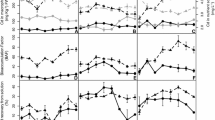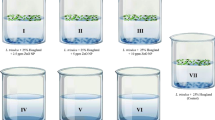Abstract
Lemna trisulca was grown in axenic cultures with regular replacement of a filter-sterilized medium. The effect of EDTA on the uptake and toxicity of Cd and Zn was examined using a two-way factorial design of varying Cd or Zn concentrations and available EDTA. When the level of available EDTA was in excess of the Cd or Zn concentration, uptake in Lemna trisulca was reduced by 96 to 99%, and correspondingly, multiplication rates were unaffected by elevated Cd or Zn concentrations. The proportion of EDTA available for chelating Cd and Zn was the amount of EDTA in excess of the Fe concentration. The antagonistic effect of the chelator EDTA suggests that, for L. trisulca, it is the free ion activity and not the total metal concentration which determines Cd and Zn uptake and toxicity.
Chelators are an essential component of a complete nutrient medium and should be included when measuring metal toxicity in aquatic plants, since Lemna trisulca grown without EDTA had low multiplication rates and appeared stunted and chlorotic. The chelator : Fe ratio, however, should be defined and controlled to avoid confounding the measurement of metal toxicity with metal-chelator interactions.
Similar content being viewed by others
References
Alder AC, Siegrist H, Gujer W, Giger W (1990) Behavior of NTA and EDTA in biological wastewater treatment. Water Res 24:733–742
American Society for Testing and Materials. (1991) Standard guide for conducting static toxicity tests with Lemna gibba G3. E1415-91. Annual Book of ASTM Standards, Vol. 11.04
Anderson MA, Morel FMM (1982) The influence of aqueous iron chemistry on the uptake of iron by the coastal diatom Thalassiosira weissflogii. Limnol Oceanog 27:789–813
Borgmann U (1983) Metal speciation and toxicity of free metal ions to aquatic biota. In: Nriagu JO (ed), Aquatic toxicology. John Wiley and Sons, NY, pp. 47–72
Borgmann U, Norwood WP, Babirad IM (1991) Relationship between chronic toxicity and bioaccumulation of cadmium in Hyallela azteca. Can J Fish Aquat Sci 48:1055–1060
Foster PL, Morel FMM (1982) Reversal of cadmium toxicity in a diatom: An interaction between cadmium activity and iron. Limnol Oceanogr 27:745–752
Frank R, Rau H (1990) Photochemical transformation in aqueous solution and possible environmental fate of ethylenediaminetetraacetic acid (EDTA). Ecotoxicol Environ Safety 19:55–63
Garvey JE, Owen HA, Winner RW (1991) Toxicity of copper to the green algae, Chlamydomonas reinhardtii (Chlorophyceae), as affected by humic substances of terrestrial and freshwater origin. Aquat Toxicol 19:89–96
Harrison GI, Morel FMM (1983) Antagonism between cadmium and iron in the marine diatom Thalassiosira weissflogii. J Phycol 19:495–507
Hillman WS (1961) The Lemnaceae, or duckweeds. Bot Rev 27:221–283
Huebert DB, Mcllraith AL, Shay JM, Robinson GGC (1990) Axenic culture of Lemna trisulca. Aquat Bot 38:295–301
Huebert DB, Shay JM (1991) The effect of cadmium and its interaction with calcium in the submerged aquatic macrophyte Lemna trisulca. Aquat Toxicol 20:57–72
--, -- (1992) Zinc toxicity and its interaction with cadmium in the submerged aquatic macrophyte Lemna trisulca L. Environ Toxicol Chem 11 (in press)
Hughes JS, Alexander MM, Balu K (1988) An evaluation of appropriate expressions of toxicity in aquatic plant bioassays as demonstrated by the effect of atrazine on algae and duckweeds. In: Adams WJ, Chapman GA, Landis WG (eds), Aquatic toxicology and hazard assessment: 10th volume, ASTM STP 971, American Society for Testing and Materials, Philadelphia, pp 531–547
Hughes JS (1991) The use of aquatic plant toxicity tests in biomonintoring programs. 18th Aquatic Toxicity Workshop. Sept. 30–Oct. 3, Ottawa, Ontario (in press)
Kwan KHM, Smith S (1991) Some aspects of the kinetics of cadmium and thallium uptake by fronds of Lemna minor L. New Phytol 117:91–102
Landolt E, Kandeler R (1987) Biosystematic investigations in the family of duckweeds (Lemnaceae). (Vol. 4). The family of Lemnaceae—a monographic study, vol 2. Veröffentlichungen des Geobotanischen Institutes der ETH, Stiftung Rübel, Zürich, 95 Heft, 638 pp
Lockhart HB Jr, Blakeley RV (1975) Aerobic photodegradation of Fe(III)-(Ethylenedinitrilo) tetraacetate (Fe-EDTA). Environ Sci Technol 9:1035–1038
Metaxas A, Lewis AG (1991) Copper tolerance of Skeletonema costatum and Nitzschia thermalis. Aquat Toxicol 19:265–280
Nasu Y, Kugimoto M, Tanaka O, Takimoto A (1983) Comparative studies on the absorption of cadmium and copper in Lemna paucicostata. Environ Pollut A 32:201–209
Nor YM, Cheng HH (1986) Chemical speciation and bioavailability of copper: uptake and accumulation by Eichornia. Environ Toxicol Chem 5:941–947
Polar E, Kücükcezzar R (1986) Influence of some metal chelators and light regimes on bioaccumulation and toxicity of Cd+2 in duckweed (Lemna gibba). Physiol Plant 66:87–93
Rand GM, Petrocelli SR (1985) Fundamentals of aquatic toxicology. Hemisphere Publishing Corp, NY, 666 pp
Schreinemakers WAC, Dorhout R (1985) Effects of copper ions on growth and ion absorbtion by Spirodela polyrhiza. J Plant Physiol 121:343–351
Skoog DA, West DM (1969) Fundamentals of analytical chemistry. Holt, Rinehart and Winston, Toronto, 835 pp
Tanaka O, Nasu Y, Takimoto A, Kugimoto M (1982) Absorption of copper by Lemna as influenced by some factors which nullify the copper effect on flowering and growth. Plant Cell Physiol 23:1291–1296
Taraldsen JE, Norberg-King TJ (1990) New method for determining effluent toxicity using duckweed (Lemna minor). Environ Toxicol Chem 9:761–767
U. S. Environmental Protection Agency (1985) Lemna acute toxicity test. Fed Reg 50:39331–39333
Wang W (1990) Literature review on duckweed toxicity testing. Environ Res 52:7–22
Author information
Authors and Affiliations
Rights and permissions
About this article
Cite this article
Huebert, D.B., Shay, J.M. The effect of EDTA on cadmium and zinc uptake and toxicity in Lemna trisulca L.. Arch. Environ. Contam. Toxicol. 22, 313–318 (1992). https://doi.org/10.1007/BF00212092
Received:
Revised:
Issue Date:
DOI: https://doi.org/10.1007/BF00212092




